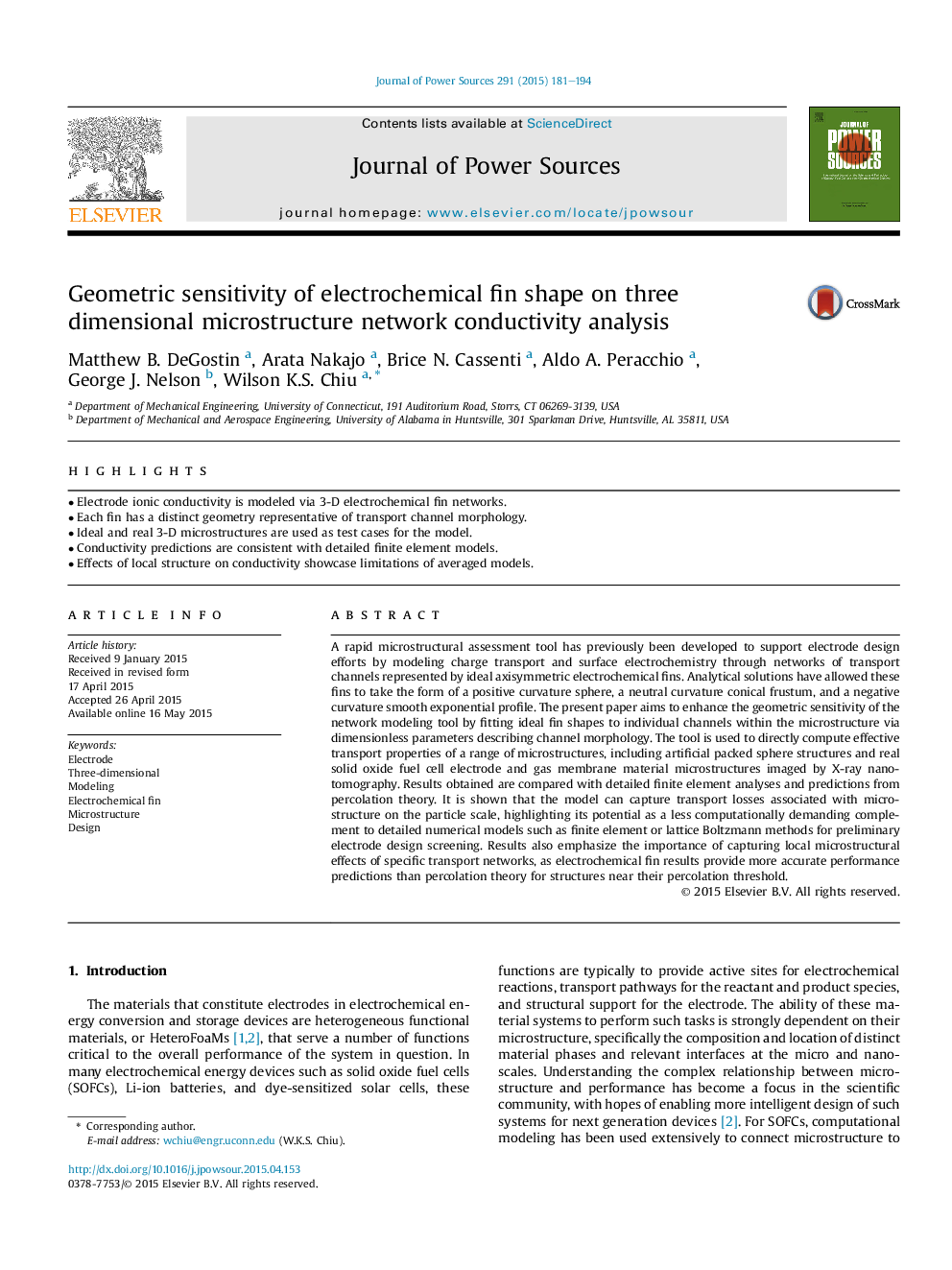| کد مقاله | کد نشریه | سال انتشار | مقاله انگلیسی | نسخه تمام متن |
|---|---|---|---|---|
| 7731171 | 1497941 | 2015 | 14 صفحه PDF | دانلود رایگان |
عنوان انگلیسی مقاله ISI
Geometric sensitivity of electrochemical fin shape on three dimensional microstructure network conductivity analysis
ترجمه فارسی عنوان
حساسیت هندسی شکل بلور الکتروشیمیایی بر روی تحلیل هدایت شبکه سه بعدی ساختاری شبکه
دانلود مقاله + سفارش ترجمه
دانلود مقاله ISI انگلیسی
رایگان برای ایرانیان
کلمات کلیدی
الکترود، سه بعدی، مدل سازی، باله الکتروشیمیایی، ریز ساختار، طرح،
ترجمه چکیده
ابزار ارزیابی سریع میکرو سازنده قبلا برای حمایت از تلاش های طراحی الکترود با مدل سازی انتقال بار و الکتروشیمی سطحی از طریق شبکه های کانال های حمل و نقل با نماینده یاب های الکتروشیمیایی ایده آل نامشخص ساخته شده است. راه حل های تحلیلی اجازه می دهد که این باله ها به شکل یک میدان انحنای مثبت، یک منحنی خنثی خنثی مخروطی و مشخصات منحنی انعطاف پذیری منفی باشد. مقاله حاضر با هدف تعیین حساسیت هندسی ابزار مدلسازی شبکه، با در نظر گرفتن اتصالات ایده آل پره ها به کانال های منحصر به فرد در میکروساختار، از طریق پارامترهای بدون بعدی که توصیف مورفولوژی کانال را توصیف می کند، افزایش می یابد. این ابزار به طور مستقیم برای محاسبه خواص مؤثر حمل و نقل از طیف وسیعی از ریزساختارها، از جمله ساختار کلاسیک مصنوعی بسته بندی شده و الکترودهای سلول سوختی اکسید واقعی و میکروساختارهای غشایی گاز تصویر شده توسط نانوتموگرافی اشعه ایکس استفاده می شود. نتایج بدست آمده با تحلیل دقیق عناصر محدود و پیش بینی شده از نظریه نفوذ مقایسه شده است. نشان داده شده است که این مدل می تواند ضایعات حمل و نقل در ارتباط با ریزساختار را در مقیاس ذرات اندازه گیری کند، و توان بالقوه آن را به عنوان مکمل کمتری برای محاسبات به مدل های عددی دقیق مانند عددی محدود یا روش های بولتزمن شبکه ای برای غربالگری طراحی الکترود اولیه، جذب می کند. نتایج همچنین بر اهمیت جذب اثرات میکرو سازمانی محلی از شبکه های حمل و نقل خاص تاکید می کنند؛ زیرا نتایج پیوندهای الکتروشیمیایی پیش بینی عملکرد دقیقتری نسبت به تئوری نفوذ برای ساختارها در نزدیکی آستانه نفوذ آنها ارائه می دهند.
موضوعات مرتبط
مهندسی و علوم پایه
شیمی
الکتروشیمی
چکیده انگلیسی
A rapid microstructural assessment tool has previously been developed to support electrode design efforts by modeling charge transport and surface electrochemistry through networks of transport channels represented by ideal axisymmetric electrochemical fins. Analytical solutions have allowed these fins to take the form of a positive curvature sphere, a neutral curvature conical frustum, and a negative curvature smooth exponential profile. The present paper aims to enhance the geometric sensitivity of the network modeling tool by fitting ideal fin shapes to individual channels within the microstructure via dimensionless parameters describing channel morphology. The tool is used to directly compute effective transport properties of a range of microstructures, including artificial packed sphere structures and real solid oxide fuel cell electrode and gas membrane material microstructures imaged by X-ray nanotomography. Results obtained are compared with detailed finite element analyses and predictions from percolation theory. It is shown that the model can capture transport losses associated with microstructure on the particle scale, highlighting its potential as a less computationally demanding complement to detailed numerical models such as finite element or lattice Boltzmann methods for preliminary electrode design screening. Results also emphasize the importance of capturing local microstructural effects of specific transport networks, as electrochemical fin results provide more accurate performance predictions than percolation theory for structures near their percolation threshold.
ناشر
Database: Elsevier - ScienceDirect (ساینس دایرکت)
Journal: Journal of Power Sources - Volume 291, 30 September 2015, Pages 181-194
Journal: Journal of Power Sources - Volume 291, 30 September 2015, Pages 181-194
نویسندگان
Matthew B. DeGostin, Arata Nakajo, Brice N. Cassenti, Aldo A. Peracchio, George J. Nelson, Wilson K.S. Chiu,
